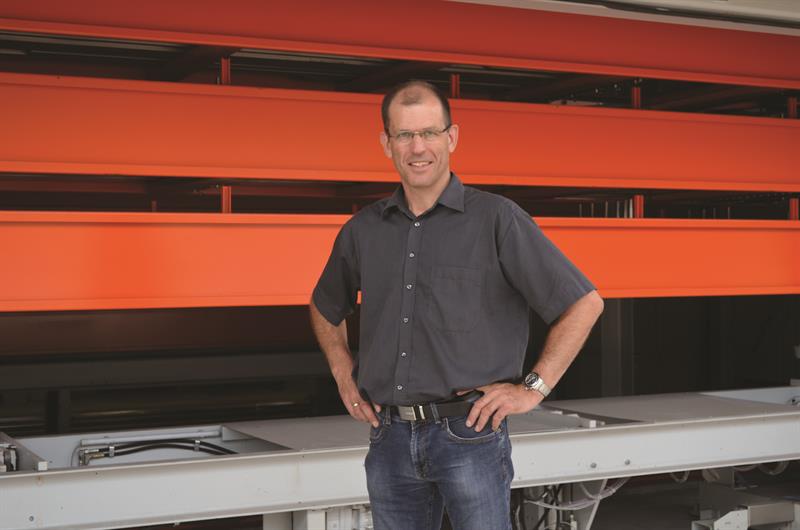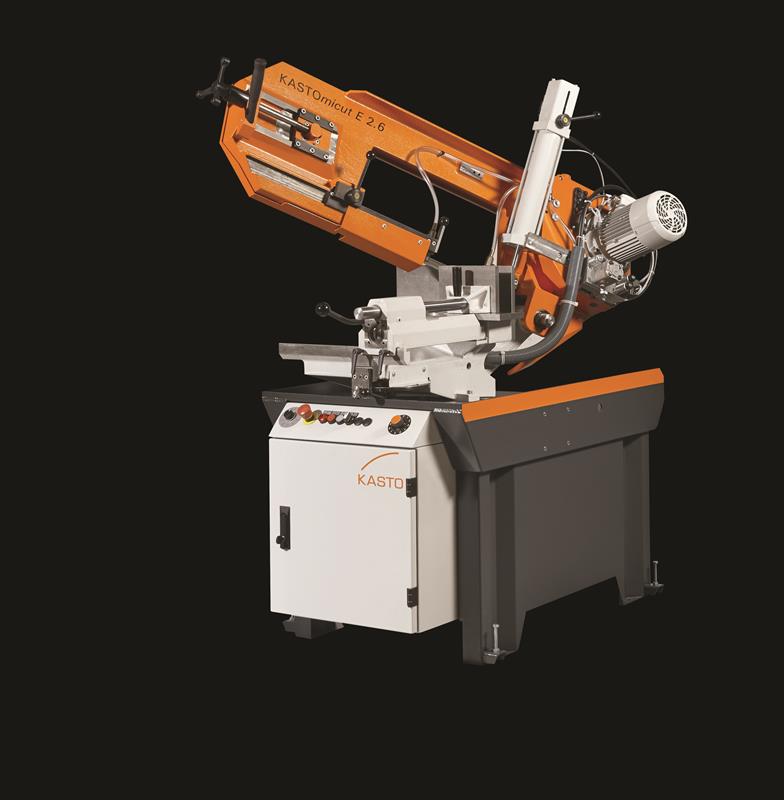German sawing and storage specialist Kasto (01908 571590) threw open the doors of its Schalkau, Thuringia, site on the occasion of its 25th anniversary. A former East German production facility, Kasto wanted to celebrate the distance the company had travelled since reunification on 3 October 1990. New Schalkau-made sawing machines were revealed at the event held in late September, as were other Kasto products (see box, below). Also included in the celebrations were two nearby customers that set up up around the time of unification.
It was the pursuit of a bargain that took Kasto most of the way across Germany to Schalkau. By the late 1980s, the main Achern, Baden-Württemburg, German factory run by the Stoltz family that owns Kasto
(the name is an abbreviation of the name of founder Karl Stoltz, who founded the business in 1844) was full up and, thanks to the poaching of staff by nearby carmaker Daimler-Benz, wages were rising, harming profitability.
Kasto’s supplier Tira operated a factory in Schalkau, making the SBL 280 U saw, and following reunification Kasto bought it and started making the SBL, HBS and SSB saw models. The site would be expanded several more times in the intervening years, and this year a factory-floor quality control office has been added. Today, the 8,000 m² operation is no longer a low-cost site but a mature assembly facility offering series production of the smaller capacity semi- or fully-automatic bandsaws, mitre circular saw, the Unitower and Unibloc tower storage systems, plus components that include electrical cabinets for saws and storage towers made in Schalkau and Achern, with total production of between 20 to 30 machines per week.
GENERATIONAL PRESENCE
At the September event, two generations of the Stoltz family were joined by the third, three-month old Victoria Krebber-Stolzer, with family members touring the factory and giving presentations. The themes of family ownership, long-term and regular investment, as well as an eye to costs, were thus set.
Several hours’ drive to the north is Marks, a metals stockholder and mould and die manufacturer based in Eisenberg, Thuringia. The stockholding operation mainly offers small quantities of bar and plate for automotive machinists and toolmakers. Speed of supply is its primary trait; orders in contiguous Germany placed on its e-commerce site www.marks-gmbh.de usually arrive the same day, thanks to two-shift operation plus lights-out machining during the working week, and two daily lorry pick-ups that feed into the distribution networks of national express couriers.
Founder Lothar Marks claims that this level of service is unique, not only in Germany but also in Europe. It relies on a smart warehouse of 70,000 products that features Kasto billet and bar saws, and storage equipment. In addition to multiple Hänel Lean-Lift tower racks for small parts (Industore, 02920 239000) and heavy duty shelving for medium-sized parts, there are Kasto tower systems for bar and sheet. To cut materials to size, it operates a fleet of nine Kasto saws.
Having first bought a Kasto saw in the early 2000s, Marks has standardised on the brand. They are not the cheapest, he offers, but more than make up for this with a level of reliability that helps to safeguard the business’s competitive edge. And if something goes wrong, Kasto’s service engineers have been quick to respond, Marks says.
Now ranging across three industrial units built from 1997-2012 on a single site, the group generates €15 million turnover from its 50 employees and of 3,000 tons of material. It is a far cry from its early years in the early 1990s, run out of a bedroom in Marks’s flat; during the day he would deliver steel kept in a trailer attached behind his car whilst his wife and daughter handled the accounts; on his return he would cut metal long into the evening.
Eighty percent of the business is metals distribution; the remainder is from die-making, primarily through the co-located company HAL Components that was established in 2000, partly to access 50% government support for new capital equipment bought by manufacturing firms. With an eye to the long term, Marks has changed the company structure and additionally created a new firm to safeguard family ownership.
An hour to the east in Weimar, Thuringia, is furniture manufacturer Schneider Stainless Steel, founded in 1991 by the ‘West’ German metalworking and transport company of the same name, and spun off to its founder’s son Jörg Schneider in 1995. It makes counters, benches and workstations for industrial kitchens, butchers, restaurants and supermarkets.

Jörg Schneider in front of his Kasto storage tower
Its manufacturing process in general consists of cutting and bending sheet metal. Current output is 6,000 components a week; a product made over the course of a week might consist of up to 15 parts.
Production flexibility has been the historical challenge. Component quantities may be large or small, down to quantities of one, and the company could not survive without both. But making all orders equally well has ben the difficulty; managing director Jörg Schneider recalls a historic bias in the factory for larger orders.
Part of its solution was to develop a standard product range, of which there are now some 8,000. More recently, it started rotating shopfloor staff; now each takes a turn on every aspect of production.
An early attempt to improve the storage and flow of material into production came in 2009 when an Amada (01562 749500) laser punch was installed with a nine-stack sheet rack and PR-III loading and unloading system, although this sadly proved inadequate for handling, on its own, a production volume that consumes 400-600 tons of steel per year. Instead, its role now is to help even out peaks in the single-shift production by feeding the laser/punch during lights-out processing.
The bulk of materials storage has moved to a €1.4 million Kasto high-bay storage racking tower, set to one side of its factory hall, which boasts exterior loading capabilities and, crucially, the ability to store multiple types of components.
The 750-location, 12.5 m Kasto storage tower has a capacity of 1,800 tons of material. It remains incomplete as it waits for customised part storage jigs that will hold semi-finished and finished products next to sheet and profile raw materials. Such is the storage tower’s process significance for the 40-employee company that three people are now tasked full-time with intralogistics, managing the flow of material off of the Kasto racks and into finished products.
In retrospect, a number of smaller, ultimately unsuccessful, production purchases were required before it took the plunge to make such a large storage investment. Indeed, Schneider expects the Kasto tower system will take 10 years to pay back.
While Europe may now seem very different to how it appeared in the early 1990s, for family firms with a sense of heritage this interval is but a single generation, during which firm ground has been laid for the next.
INTRODUCING THE FAMILY OF MICUT 2.6 BANDSAWS, AND OTHER FRIENDS
 Micut E 2.6
Micut E 2.6
Kasto’s new four-model, Schalkau-made ‘Micut’ product branding stands for mitre cutting. All of them, which vary in extent of automation, cut mitres ranging from -60° to +45°, and cut material up to 260 mm across (maximum flat capacity is 310 mm wide by 260 mm high). Also, operators can change cutting speeds using an infinitely-variable potentiometer dial, from 20 to 120 m/min, depending on the hardness of the material. Cutting accuracy is said to be 0.1 mm per 100 mm.
The base model Micut P 2.6 offers manual clamping, manual blade tensioning, manual feed rate (essentially determined by the dead weight of the frame). Cut material rests on a sacrificial cutting rail. Micut E 2.6 employs a hydraulic cylinder for automatic feed control, and material support is on a non-wearing table that rotates in line with cutting angle. In addition to these features, Micut U 2.6 offers automatic clamping, thanks to a hydraulic cylinder. Finally, Micut A 2.6, launching in 2017, is entirely automatic, plus has electric blade tension monitoring and carbide blade guides. An optional chip conveyor allows practically unattended operation.
Also new, but made elsewhere, is a high-tech automatic sawing machine for bar, the KastoWin pro AC 5.6. It claims to offer double the cutting rate of bar (based on a 300 mm diameter 42CrMo4 bar) to that of the KastoWin, thanks to a reduced vibration design that is optimised for use with a carbide blade.
Another advanced new product is an energy storage device for Kasto’s Unitower storage system that saves up to 40% of electricity costs, compared to conventional drives, by using a generator to make power as the heavy shelves descend.
This article was originally published in the November 2016 issue of Machinery magazine.




